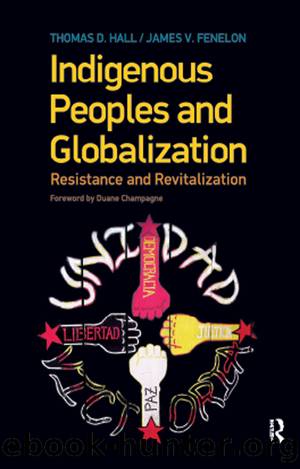Indigenous Peoples and Globalization by Thomas D. Hall James V. Fenelon

Author:Thomas D. Hall, James V. Fenelon [Thomas D. Hall, James V. Fenelon]
Language: eng
Format: epub
Tags: Social Science, Sociology, General
ISBN: 9781317257615
Google: ICYeCwAAQBAJ
Publisher: Routledge
Published: 2015-12-03T02:50:54+00:00
Web Resources
Global Exchange: The San Andrés Accords, http://www.globalexchange.org/countries/americas/mexico/SanAndres.html (accessed December 11, 2008).
Zapatista Network, http://www.zapatistas.org/ (accessed December 11, 2008).
CHAPTER 5
American Indian Survival and Revitalization
Native Nations in the United States
IN THIS CHAPTER we discuss indigenous peopleâs struggles in what has become the United States and Canada. We discuss the Wampanoag and then focus on the Lakota peoples, who together experienced one of the earliest and one of the last conquests by peoples of European ancestry in the history of the United States. We also discuss the Navajo (Diné) and more briefly several California peoples, both to add breadth to our discussion and to present the considerably different experiences of peoples first conquered and absorbed by Spain. This is a very small sample of the well over 500 different ânationsâ who inhabited the territories that eventually became the United States. Yet, we argue their collective experiences bracket the range of experiences of indigenous peoples with Europeans in the United States. These discussions add to the basis for comparing and contrasting with experiences elsewhere in the world and support our argument for why these processes and experiences require a global, as well as a local, understanding.
For each of these examples, we consider four important analytical perspectivesâhistoricity, resistance modalities of survival, social justice issues, and revitalization. For many people, American Indian peoples have become archetypes of indigenous struggles against colonialization, of limited survival, and of resistance. Some say this has risen to the level of stereotypes. Over the past fifty years or so, American Indians have become emblematic of movements to reestablish their legitimate status as sovereign nations although most of the rest of the world is in sharp conflict over the status of sovereignty, and relations in the United States are as much internal colonies as independent nations. Nonetheless, the devolution of independent native nations under colonialism and later U.S. expansion and incorporation, at times rising to the level of genocidal war, contrasts with a rising rule of law in the twentieth century affirming American Indian nations and leading to a firm sovereignty as âdomestic, dependentâ status in the United States and as âFirst Nationsâ in Canada. This compelling story varies widely by the temporal period of incorporation and the geographic location of the indigenous peoples, making each nation unique even as there are shared aspects. Therefore, we ground our discussion with descriptions of individual Indian nations, beginning with the Wampanoag peoples.
Download
This site does not store any files on its server. We only index and link to content provided by other sites. Please contact the content providers to delete copyright contents if any and email us, we'll remove relevant links or contents immediately.
Cecilia; Or, Memoirs of an Heiress — Volume 1 by Fanny Burney(32434)
Cecilia; Or, Memoirs of an Heiress — Volume 2 by Fanny Burney(31868)
Cecilia; Or, Memoirs of an Heiress — Volume 3 by Fanny Burney(31851)
The Great Music City by Andrea Baker(31327)
We're Going to Need More Wine by Gabrielle Union(18967)
All the Missing Girls by Megan Miranda(15561)
Pimp by Iceberg Slim(14378)
Bombshells: Glamour Girls of a Lifetime by Sullivan Steve(13971)
Talking to Strangers by Malcolm Gladwell(13219)
Norse Mythology by Gaiman Neil(13204)
Fifty Shades Freed by E L James(13157)
For the Love of Europe by Rick Steves(12920)
Mindhunter: Inside the FBI's Elite Serial Crime Unit by John E. Douglas & Mark Olshaker(9186)
Crazy Rich Asians by Kevin Kwan(9165)
The Lost Art of Listening by Michael P. Nichols(7403)
Enlightenment Now: The Case for Reason, Science, Humanism, and Progress by Steven Pinker(7228)
The Four Agreements by Don Miguel Ruiz(6618)
Bad Blood by John Carreyrou(6543)
Weapons of Math Destruction by Cathy O'Neil(6139)
